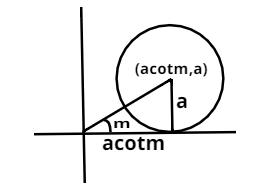
Find the polar equation of a circle, the initial line being a tangent. What does it become if the origin is on the circumference?
Answer
569.7k+ views
Hint: To find the polar equation of a circle, we need to find the equation of the circle by considering angle as ‘m’ and radius as ‘a’ and then by using the polar coordinates of the circle, the polar equation can be calculated. Polar equation of a circle refers to the equation of circle expressed in polar coordinates, which includes angle of circle.
Complete step-by-step answer:
Let us construct a figure of a circle in the coordinate axis with a tangent along x – axis and radius ‘a’.

The angle subtended by the radius of the circle with the x – axis is ‘m’ as shown in the figure. Using this we can write the coordinates of the center of the circle (a cot m, a) from the figure.
In the circle we have assumed m as angle and the radius of circle is a. The circle is shown in the figure, equation of the circle will be
We know the equation of a circle is given by the formula, ${\left( {{\text{x - a}}} \right)^2} + {\left( {{\text{y - b}}} \right)^2} = {{\text{r}}^2}$, where (a, b) is the center of the circle and ‘r’ is the radius of the circle. Therefore,
${(x - a\cot m)^2} + {(y - a)^2} = {a^2}$ (Equation of circle)
Using the radius, we can write the x and y intercepts as r cosθ and r sinθ respectively. Here radius = a.
Converting it to polar form i.e. replacing x and y with $r\cos \theta $and$r\sin \theta $, we get
\[{(r\cos \theta - a\cot m)^2} + {(r\sin \theta - a)^2} = {a^2}\]
Opening the square we get,
\[
\Rightarrow {r^2}{\cos ^2}\theta + {a^2}{\cot ^2}m - 2ar\cos \theta \cot m + {r^2}{\sin ^2}\theta + {a^2} - 2ar\sin \theta = {a^2} \\
\Rightarrow {r^2} + {a^2}{\cot ^2}m - 2r\cos \theta (a\cot m) - 2ar\sin \theta = 0 \\
\]
If the origin is on circumference, put $a\cot m = 0$ we get
$ \Rightarrow r = 2a\sin \theta $.
This is the required equation.
Note: In order to solve this type of questions the key is to just follow the steps of converting the normal coordinates to polar coordinates and making an appropriate construction to be able to solve the problem easily according to question and assigning out variables. We have to change it in polar form as done above.
Complete step-by-step answer:
Let us construct a figure of a circle in the coordinate axis with a tangent along x – axis and radius ‘a’.

The angle subtended by the radius of the circle with the x – axis is ‘m’ as shown in the figure. Using this we can write the coordinates of the center of the circle (a cot m, a) from the figure.
In the circle we have assumed m as angle and the radius of circle is a. The circle is shown in the figure, equation of the circle will be
We know the equation of a circle is given by the formula, ${\left( {{\text{x - a}}} \right)^2} + {\left( {{\text{y - b}}} \right)^2} = {{\text{r}}^2}$, where (a, b) is the center of the circle and ‘r’ is the radius of the circle. Therefore,
${(x - a\cot m)^2} + {(y - a)^2} = {a^2}$ (Equation of circle)
Using the radius, we can write the x and y intercepts as r cosθ and r sinθ respectively. Here radius = a.
Converting it to polar form i.e. replacing x and y with $r\cos \theta $and$r\sin \theta $, we get
\[{(r\cos \theta - a\cot m)^2} + {(r\sin \theta - a)^2} = {a^2}\]
Opening the square we get,
\[
\Rightarrow {r^2}{\cos ^2}\theta + {a^2}{\cot ^2}m - 2ar\cos \theta \cot m + {r^2}{\sin ^2}\theta + {a^2} - 2ar\sin \theta = {a^2} \\
\Rightarrow {r^2} + {a^2}{\cot ^2}m - 2r\cos \theta (a\cot m) - 2ar\sin \theta = 0 \\
\]
If the origin is on circumference, put $a\cot m = 0$ we get
$ \Rightarrow r = 2a\sin \theta $.
This is the required equation.
Note: In order to solve this type of questions the key is to just follow the steps of converting the normal coordinates to polar coordinates and making an appropriate construction to be able to solve the problem easily according to question and assigning out variables. We have to change it in polar form as done above.
Recently Updated Pages
Master Class 11 Economics: Engaging Questions & Answers for Success

Master Class 11 English: Engaging Questions & Answers for Success

Master Class 11 Social Science: Engaging Questions & Answers for Success

Master Class 11 Biology: Engaging Questions & Answers for Success

Class 11 Question and Answer - Your Ultimate Solutions Guide

Master Class 11 Business Studies: Engaging Questions & Answers for Success

Trending doubts
What is meant by exothermic and endothermic reactions class 11 chemistry CBSE

10 examples of friction in our daily life

One Metric ton is equal to kg A 10000 B 1000 C 100 class 11 physics CBSE

Difference Between Prokaryotic Cells and Eukaryotic Cells

What are Quantum numbers Explain the quantum number class 11 chemistry CBSE

1 Quintal is equal to a 110 kg b 10 kg c 100kg d 1000 class 11 physics CBSE




